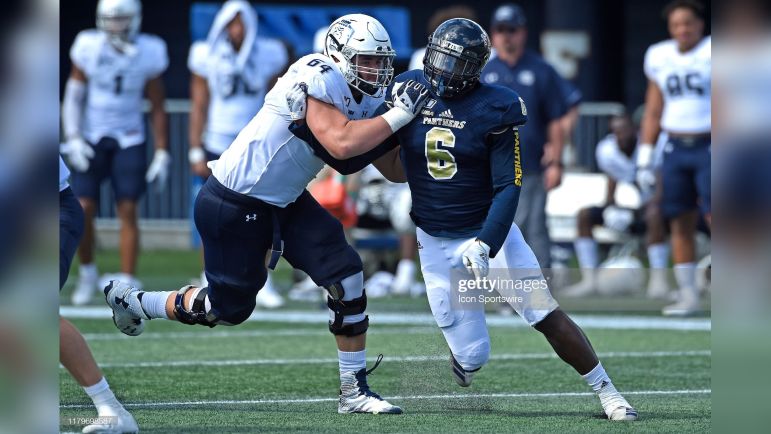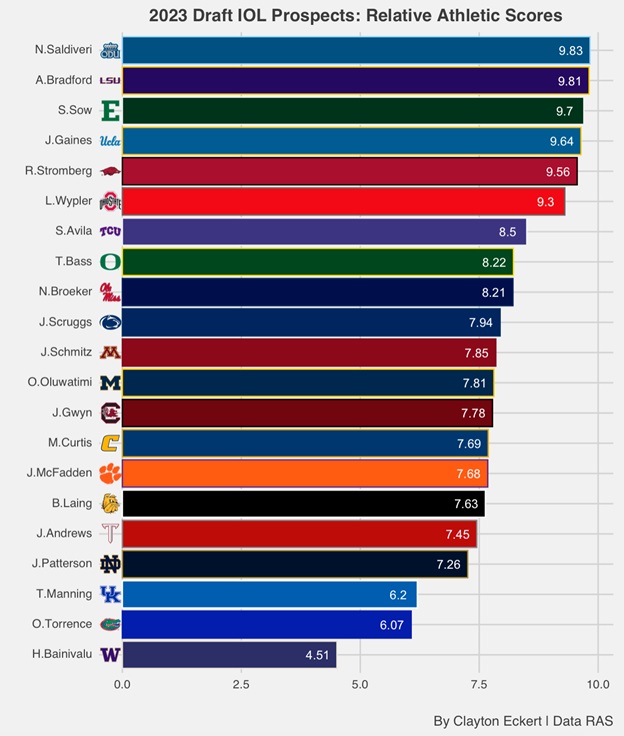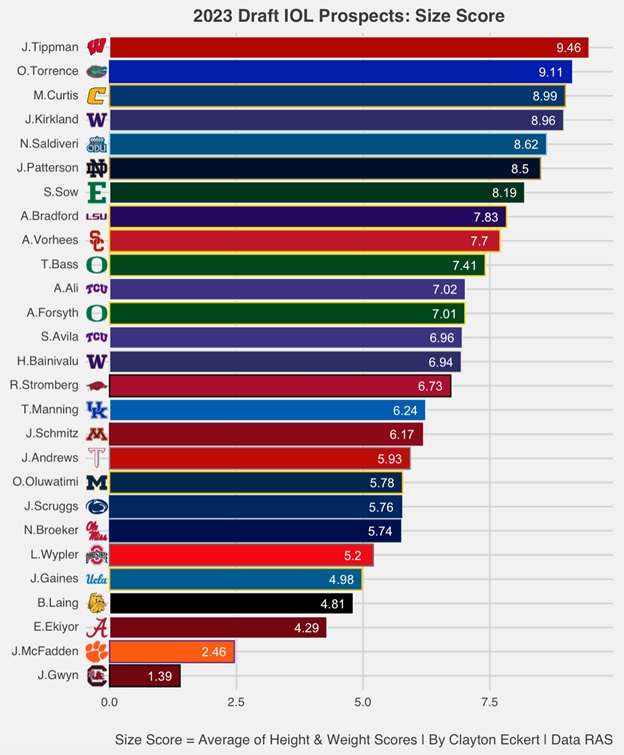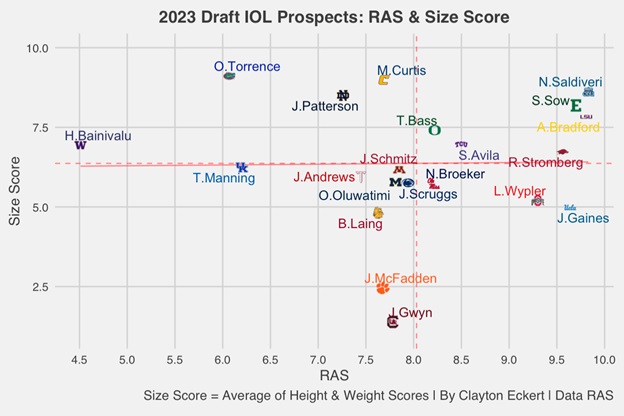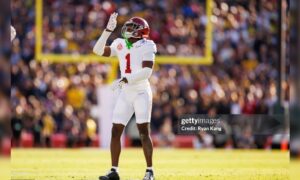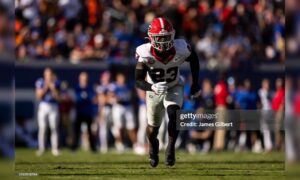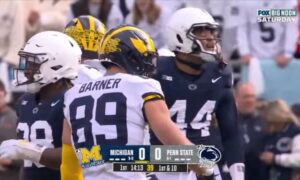Today I wanted to visualize some great data from Kent Lee Platt’s Relative Athletic Scores (RAS) for the interior offensive line. Here is a link to Platt’s website in case you haven’t seen his work https://ras.football/. To qualify for a RAS score, a player must have a total of six recorded metrics from any of the following: Height, Weight, Forty-yard dash, Twenty-yard split, Ten-yard split, Bench Press, Vertical Jump, Broad Jump, Short Shuttle, and 3-Cone. The player is then graded on each in comparison to the positional database since 1987 to get more of a feel of their size, speed, explosion, agility, and total value, giving context to the raw numbers.
The goal of the series is to provide the RAS from Platt, with a bit of my own twist with a size score and visualize it to get a simultaneous view of all the players at their position that participated at the combine. Here are the players that qualified for a RAS (NOTE: Positions are grouped from the Combine results tracker compiled by Dave Bryan and Alex Kozora and size scores are grouped by their RAS position of guard or center):
Right away we see six prospects with +nine RAS scores, compared to eight in the 2022 draft. Topping this year’s list is Old Dominion’s Nick Saldiveri (9.83 RAS) who has elite explosion, great size and speed, but didn’t qualify in agility, with a 1.7 10-yard split his best mark and 24 reps on the bench his lowest yet acceptable mark. LSU’s Anthony Bradford (9.81 RAS) has elite speed, great explosion, good size and agility, with a 1.66 10-yard split his best mark and a 4.8 shuttle his lowest (acceptable) mark. Eastern Michigan’s Sidy Sow (9.7 RAS) has elite explosion, great size and agility, good speed, with a 32” vertical his best mark and a 1.82 10-yard split his lowest number that is still within Pittsburgh’s standards. UCLA’s Jon Gaines (9.64 RAS) has elite speed, explosion, and agility, okay size, with a 1.65 10-yard split that scored a perfect ten in the historical database, but 19 reps on the bench that is lower than Pittsburgh’s draft history. Ricky Stromberg of Arkansas (9.56 RAS) has elite explosion, great agility, good size and speed, with a 32.5 vertical his best mark and a 5.27 40-yard dash his lowest drill (acceptable). Ohio State’s Luke Wypler (9.3 RAS) has great speed and explosion, good agility, okay size, with a 1.73 10-yard split his best workout and height (6025) lower than what the Steelers have typically drafted.
After a dropoff, we have three players in the eight range. TCU’s Steve Avila (8.5 RAS) has good size, speed, and agility, okay explosion, with weight (332) his best result and the lowest an 802 broad (acceptable). Oregon’s TJ Bass (8.22 RAS) has great explosion, good size, okay speed, but no agility testing, with a 901 broad jump his best workout and a 5.48 40-yard dash his lowest which is just outside of what Pittsburgh has typically drafted. Nick Broeker of Ole Miss (8.21 RAS) has good speed and agility, okay size, but no explosion numbers, with a 1.76 10-yard split his best mark and weight (305) his lowest yet acceptable result.
Several prospects (nine) land in the seven tier. Penn State’s Juice Scruggs (7.94 RAS) has good speed and explosion, okay size, but poor agility, with a 32” vertical his best number and a 4.82 shuttle his lowest yet acceptable result. Minnesota’s John Michael Schmitz (7.85 RAS) has good size and explosion, okay speed, but didn’t qualify in agility, with a 4.56 shuttle his best mark and a 5.35 40-yard dash his lowest (acceptable). Michigan’s Olusegun Oluwatimi (7.81 RAS) has great explosion, good agility, okay size and speed, with a 902 broad jump his best workout and a 5.38 40-yard dash the lowest yet in Pittsburgh’s past standards. South Carolina’s Jovaughn Gwyn (7.78 RAS) has elite speed, good explosion, okay agility, but very poor size, with a 1.73 10-yard split his best mark and historically low height (6017) and weight that is less than Pittsburgh typically goes for.
Chattanooga’s McClendon Curtis (7.69 RAS) has great size, good speed and explosion, okay agility, with height (6057) his best result and a 4.97 shuttle his lowest and just outside of the Steelers draft history. Clemson’s Jordan McFadden (7.68 RAS) has elite speed, good agility, but very poor size and didn’t qualify in explosion, with a 4.99 40-yard dash his best mark and height (6022) low for the guard position. Minnesota Duluth’s Brent Laing (7.63 RAS) has great agility, good speed and explosion, okay size, with a 7.63 three-cone his best mark and weight (304) his lowest (acceptable) number. Troy’s Jake Andrews (7.45 RAS) has great speed, okay size, explosion, and agility, with a 1.77 10-yard split his best result and a 26” vertical the lowest (within Pittsburgh’s draft history). Notre Dame’s Jarrett Patterson (7.26 RAS) has great size, good speed and explosion, but poor agility, with height (6051) his best result but 22 reps on the bench lower than the Steelers typically have drafted.
After another big dropoff, there are two players in the six range. Kentucky’s Tashawn Manning (6.2 RAS) has good size and explosion, okay speed and agility, with weight (327) his best and height (6031) his lowest yet acceptable number. Florida’s O’Cyrus Torrence (6.07 RAS) has elite size, good speed, but poor explosion and agility, with height (6053) and weight (330) tied for his best marks and a 23.5 vertical that is a bit lower than Pittsburgh’s draft history.
After a huge drop off we see the final prospect, Washington’s Henry Bainivalu (4.51 RAS) who has good size and explosion, okay speed, but very poor agility, with height (6056) his best result but an 8.34 three-cone that is outside of the Steelers draft history.
Next, I wanted to provide more context with a size score using the RAS for the players’ height and weight, which includes all the combine invites since all the players are measured:
Two players have nine+ size scores, starting with Wisconsin center Joe Tippman (6060, 313) who has elite size for the position but didn’t qualify for a RAS with no athletic testing. Torrence (6053, 330) provides the best size of the guards but had the second-lowest RAS with 23 reps on the bench and 23.5 vertical outside of Pittsburgh’s draft history.
Five players have eight size scores. Curtis (6057, 324) definitely fits in this regard, but his 4.97 shuttle a bit outside of the Steelers past tendencies. Washington’s Jaxson Kirkland (6067, 321) didn’t qualify for an RAS due to only measuring and 19 reps on the bench, which is low for the guard position, but right at Pittsburgh’s threshold at the tackle position, which some view him as. Saldiveri (6062, 318) pairs this with the top-ranked 9.83 RAS at guard, but 24 reps on the bench a bit lower than Pittsburgh’s tendencies, fitting the bill similar to Kirkland for those that see him as a tackle. Patterson (6051, 306) has great a great size score at center, but his 31 3/8” arms, 22 reps on the bench, and 7.96 three-cone would set new precedents. Sow (6046, 323) pairs this great size with the third-ranked 9.7 RAS, fitting black and gold standards in every way athletically.
In the seven tier, we have another five prospects, starting with Bradford (6040, 332) who fits well overall including the second-ranked 9.81 RAS, but a 7.84 three-cone would set a new precedent. USC’s Andrew Vorhees (6060, 310) unfortunately was injured in the pre-draft process and didn’t qualify for an RAS with no speed or agility testing, but fits in all size and explosion metrics with his 38 reps on the bench despite being injured the impressive highlight. Bass (6043, 317) fits the size mold but misses with 9 1/4” hands and a 5.48 40-yard dash. TCU center Alan Ali (6042, 301) has good size for the position but only measured along with a 26.5 broad that all meet past Steelers standards. Oregon’s Alex Forsyth (6037, 303) similarly didn’t qualify for a RAS, meeting the size mold but a 20.5 vertical that would set a new precedent.
Five more players land in the sixes, starting with Avila (6034, 332) due to lower height (that is within Steelers standards), but 9 ¼” hands and a 7.85 three-cone that are not. Bainivalu (6056, 306) has good size, but the lowest 4.51 RAS by far, with his 5.5 40-yard dash, 4.97 shuttle, and 8.34 three-cone that are outside Pittsburgh’s draft history. Stromberg (6032, 306) fits very well highlighted by his 9.56 RAS, but didn’t participate on the bench. Manning (6031, 327) has good size at guard but his 7.9 three-cone would set a new precedent. Schmitz (6034, 301) fits in every drill he participated in, but didn’t participate in the thre-cone.
Five prospects once again, this time in the five range (where size thresholds begin to factor in): Andrews (6026, 306) missing in height, Oluwatimi (6024, 309) also missing in height, with Scruggs an exception (6032, 301) and checking every athletic box as well, Broeker (6043, 305) fitting the size bill but 23 on the bench would be a new precedent, and Wypler (6025, 303) missing the Steelers past tendencies due to his height.
In the four tier, there are three players: Gaines (6040, 303) fits in this regard along with a 9.64 RAS and checks many boxes except for his low 19 reps on the bench. Laing (6037, 304) fares very similar hitting much of what Pittsburgh looks for, but 24 reps on the bench would set a new precedent as well. Alabama’s Emil Eyikor (6024, 314) misses in height and also on the bench (23 reps).
After a big drop off to the two range, we see McFadden (6022, 303) with his height and 24 bench reps missing the mark along with no broad jump.
The final prospect is Gwyn with a 1.39 size score (6017, 297) that is a pretty safe bet to land elsewhere.
To wrap up, here is a visual layering the RAS and size score to take it all in:
Saldiveri and Sow have the best balance of the data points with above nine RAS’s and + eight size scores, with the latter being the ideal Steelers fit in my opinion. Bradford lands close to them as well, with a +nine RAS and an above-seven size score. Other players that were above average in both were Stromberg, Avila, and Bass with the former being the best fit in Pittsburgh from what we’ve learned. Players on the bottom right who fared well athletically but have below-average size were Gaines and Wypler, but miss Pittsburgh’s tendencies in one way or another. Torrence, Curtis, and Patterson highlight the top left with size but below-average athleticism, but similarly miss the Steelers past draft tendencies in one way or another. It will be interesting to see if Pittsburgh drafts the position with the attention they gave the room in free agency.
For those that like the numbers, it’s unfortunate a few players didn’t test fully, and it will be interesting to monitor the pro days and continue to see how the men stack up in the coming weeks when Platt updates the site with the unofficial numbers.
What are your thoughts on the data? Thanks for reading and let me know your thoughts in the comments.

